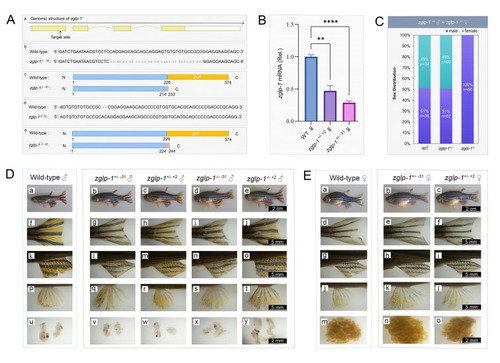
The lack of females observed in zglp-1−/− mutants is attributed to sex reversal. A The CRISPR/Cas9 target location and zebrafish zglp-1 mutant varieties. a. The intended knockout site for the zglp-1 gene was located within exon 1, denoted by the boxed exons. The translated regions are marked by yellow squares, whereas the untranslated regions are indicated by white squares. The folded line represents introns. b and c. In comparison to the wild type, mutant 1 exhibited a deletion of 31 bases, resulting in premature translation termination at the 233rd amino acid. d and e. Mutant 2 differed from the wild type by the insertion of two bases and the substitution of one base, causing translation to halt prematurely at the 244th amino acid. B The expression of zglp-1 in wild-type and zglp-1 mutant zebrafish by quantitative real-time PCR. actb1 served as the loading control in our study. The data presented here represent the mean values with standard deviations (mean ± SD). Statistical analysis was performed using one-way ANOVA. (**P < 0.01, ***P < 0.001). C Details of the counts (n) and proportions (%) of female and male offspring resulting from a cross between zglp-1 heterozygous mutant zglp-1± +2 males and zglp-1± +2 females, categorized accordingly. D Primary and secondary sex characteristics of zglp-1 male mutants. The body (a–e), caudal fin (f–j), genital papilla (k–o), anal fin (p–t), and gonad at the cloaca (u–y) were observed (n = 10). E Primary and secondary sex characteristics of zglp-1 female mutants. The body (a–c), caudal fin (d–f), genital papilla (g–i), anal fin (j–l), and gonad at the cloaca (m–o) were observed (n = 10)
|

